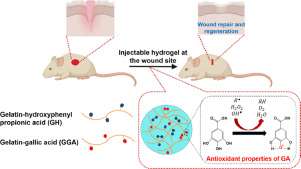当前位置:
X-MOL 学术
›
Acta Biomater.
›
论文详情
Our official English website, www.x-mol.net, welcomes your feedback! (Note: you will need to create a separate account there.)
In situ forming and reactive oxygen species-scavenging gelatin hydrogels for enhancing wound healing efficacy.
Acta Biomaterialia ( IF 9.7 ) Pub Date : 2019-12-14 , DOI: 10.1016/j.actbio.2019.12.009 Phuong Le Thi 1 , Yunki Lee 1 , Dieu Linh Tran 1 , Thai Thanh Hoang Thi 2 , Jeon Il Kang 3 , Kyung Min Park 3 , Ki Dong Park 1
Acta Biomaterialia ( IF 9.7 ) Pub Date : 2019-12-14 , DOI: 10.1016/j.actbio.2019.12.009 Phuong Le Thi 1 , Yunki Lee 1 , Dieu Linh Tran 1 , Thai Thanh Hoang Thi 2 , Jeon Il Kang 3 , Kyung Min Park 3 , Ki Dong Park 1
Affiliation

|
The overexpression of reactive oxygen species (ROS) contributes to the pathogenesis of numerous diseases such as atherosclerosis, myocardial infarction, cancer, and chronic inflammation. Therefore, the development of materials that can locally control the adverse effects resulting from excessive ROS generation is of great significance. In this study, the antioxidant gallic acid-conjugated gelatin (GGA) was introduced into gelatin-hydroxyphenyl propionic (GH) hydrogels to create an injectable hydrogel with enhanced free radical scavenging properties compared to pure GH hydrogels. The modified hydrogels were rapidly formed by an HRP-catalyzed cross-linking reaction with high mechanical strength and biodegradability. The resulting GH/GGA hydrogels effectively scavenged the hydroxyl radicals and DPPH radicals, and the scavenging capacity could be modulated by varying GGA concentrations. Moreover, in an in vitro H2O2-induced ROS microenvironment, GH/GGA hydrogels significantly suppressed the oxidative damage of human dermal fibroblast (hDFBs) and preserved their viability by reducing intracellular ROS production. More importantly, the ROS scavenging hydrogel efficiently accelerated the wound healing process with unexpected regenerative healing characteristics, shown by hair follicle formation; promoted neovascularization; and highly ordered the alignment of collagen fiber in a full-thickness skin defect model. Therefore, we expect that injectable GH/GGA hydrogels can serve as promising biomaterials for tissue regeneration applications, including wound treatment and other tissue repair related to ROS overexpression. STATEMENT OF SIGNIFICANCE: Recently, many researchers have endeavored to develop injectable hydrogel matrices that can modulate the ROS level to normal physiological processes for the treatment of various diseases. Here, we designed an injectable gelatin hydrogel in which gallic acid, an antioxidant compound, was conjugated onto a gelatin polymer backbone. The hydrogels showed tunable properties and could scavenge the free radicals in a controllable manner. Because of the ROS scavenging properties, the hydrogels protected the cells from the oxidative damage of ROS microenvironment and effectively accelerated the wound healing process with high quality of healed skin. We believe that this injectable ROS scavenging hydrogel has great potential for wound treatment and tissue regeneration, where oxidative damage by ROS contributes to the pathogenesis.
中文翻译:

原位形成和清除活性氧的明胶水凝胶可增强伤口愈合功效。
活性氧(ROS)的过表达助长了多种疾病的发病机理,例如动脉粥样硬化,心肌梗塞,癌症和慢性炎症。因此,开发能够局部控制由于过量ROS产生而产生的不利影响的材料具有重要意义。在这项研究中,将抗氧化剂没食子酸共轭明胶(GGA)引入到明胶-羟苯基丙酸(GH)水凝胶中,以创建与纯GH水凝胶相比具有增强的自由基清除性能的可注射水凝胶。改性的水凝胶是通过HRP催化的具有高机械强度和生物降解性的交联反应迅速形成的。所得的GH / GGA水凝胶有效清除了羟基自由基和DPPH自由基,并且清除能力可以通过改变GGA浓度来调节。此外,在体外H2O2诱导的ROS微环境中,GH / GGA水凝胶显着抑制了人类皮肤成纤维细胞(hDFBs)的氧化损伤,并通过减少细胞内ROS的产生保留了它们的生存能力。更重要的是,清除ROS的水凝胶有效地加速了伤口的愈合过程,并具有出乎意料的再生愈合特性,表现为毛囊的形成。促进新血管形成;并在全层皮肤缺损模型中对胶原纤维的排列进行了高度排序。因此,我们期望可注射的GH / GGA水凝胶可以作为有希望的生物材料用于组织再生应用,包括伤口治疗和与ROS过表达相关的其他组织修复。重要性声明:最近,许多研究人员致力于开发可将ROS水平调节至正常生理过程以治疗各种疾病的可注射水凝胶基质。在这里,我们设计了一种可注射的明胶水凝胶,其中,一种抗氧化剂化合物没食子酸被缀合到了明胶聚合物主链上。水凝胶显示出可调节的性质,并且可以以可控的方式清除自由基。由于具有ROS清除特性,因此水凝胶可保护细胞免受ROS微环境的氧化损害,并以高质量的愈合皮肤有效地加速伤口的愈合过程。我们认为,这种可注射的ROS清除水凝胶在伤口治疗和组织再生方面具有巨大潜力,其中ROS的氧化损伤会促进发病机理。
更新日期:2019-12-17
中文翻译:

原位形成和清除活性氧的明胶水凝胶可增强伤口愈合功效。
活性氧(ROS)的过表达助长了多种疾病的发病机理,例如动脉粥样硬化,心肌梗塞,癌症和慢性炎症。因此,开发能够局部控制由于过量ROS产生而产生的不利影响的材料具有重要意义。在这项研究中,将抗氧化剂没食子酸共轭明胶(GGA)引入到明胶-羟苯基丙酸(GH)水凝胶中,以创建与纯GH水凝胶相比具有增强的自由基清除性能的可注射水凝胶。改性的水凝胶是通过HRP催化的具有高机械强度和生物降解性的交联反应迅速形成的。所得的GH / GGA水凝胶有效清除了羟基自由基和DPPH自由基,并且清除能力可以通过改变GGA浓度来调节。此外,在体外H2O2诱导的ROS微环境中,GH / GGA水凝胶显着抑制了人类皮肤成纤维细胞(hDFBs)的氧化损伤,并通过减少细胞内ROS的产生保留了它们的生存能力。更重要的是,清除ROS的水凝胶有效地加速了伤口的愈合过程,并具有出乎意料的再生愈合特性,表现为毛囊的形成。促进新血管形成;并在全层皮肤缺损模型中对胶原纤维的排列进行了高度排序。因此,我们期望可注射的GH / GGA水凝胶可以作为有希望的生物材料用于组织再生应用,包括伤口治疗和与ROS过表达相关的其他组织修复。重要性声明:最近,许多研究人员致力于开发可将ROS水平调节至正常生理过程以治疗各种疾病的可注射水凝胶基质。在这里,我们设计了一种可注射的明胶水凝胶,其中,一种抗氧化剂化合物没食子酸被缀合到了明胶聚合物主链上。水凝胶显示出可调节的性质,并且可以以可控的方式清除自由基。由于具有ROS清除特性,因此水凝胶可保护细胞免受ROS微环境的氧化损害,并以高质量的愈合皮肤有效地加速伤口的愈合过程。我们认为,这种可注射的ROS清除水凝胶在伤口治疗和组织再生方面具有巨大潜力,其中ROS的氧化损伤会促进发病机理。


























 京公网安备 11010802027423号
京公网安备 11010802027423号